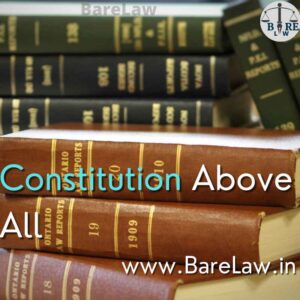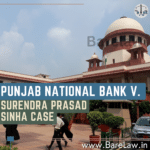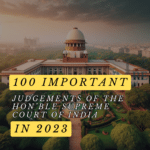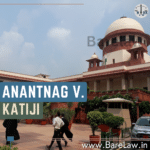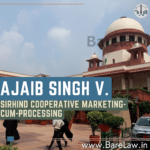CASE NAME- K. M. NANAVATI V. STATE OF MAHARASHTRA
CITATIONS- [CITATION: 1962 AIR 605]
COURT: SUPREME COURT OF INDIA
BENCH: SUBBARAO, K.DAS, S.K. DAYAL, RAGHUBAR
APPELLANT: K.M. NANAVATI
RESPONDENT: STATE OF MAHARASHTRA
CASE SUMMARY
STATEMENT OF FACTS
- Kevas Manekshaw Nanavati was an Indian Naval Officer who shifted along with his family to Bombay in 1959 where he met Prem Bhagwandas Ahuja, a businessman in Bombay. His wife came into an illicit relationship with Prem Ahuja.
- KM Nanavati’ lost his temper after hearing about his wife’s confession about her relationship with Prem Ahuja Further; he went to his boat to acquire a stacked pistol and drove himself to Prem Ahuja’s office. On not discovering him in his office, he then, at that point headed to his home.
- After a fight, at his home, two shots went off unintentionally and hit Ahuja and the accused surrendered to the police station.
- The jury got a decision of “not guilty” by 8: 1 under both the sections; however the Sessions Judge disagreed with the decision of the jury, as in his see the greater part decision of the jury was to such an extent that no reasonable body of men could, having respect to the proof, acquire such a decision.
- After recording the grounds for his opinion, the learned Sessions Judge submitted the case under Section 307 of the Code of Criminal Procedure, 1973 [Power to direct tender of pardon] to the Bombay High Court.
- After hearing the submission by the Session Court, the High Court enumerated that accused was guilty of the offense of murder under Section 302 of the Indian Penal Code, 1860 [Punishment for Murder] and sentenced him to undergo rigorous imprisonment for life.
- Then through a Special Leave Petition, the convict approached the court to seek redressal, also an application was made to the governor under Article 161 [Power of the Governor to grant Pardons].
ISSUES RAISED
- Whether the Special Leave Petition can be engaged without fulfilling the solicitation under Article 142 of the Indian Constitution [Enforcement of decrees and orders of Supreme Court and unless as to discovery, etc].
- Whether the Pardoning force of Governor and Special Leave Petition can be moved together.
CONTENTIONS
APPELLANT
- The conflict set forth by the direction of Nanavati was that subsequent to hearing Sylvia’s admission, Nanavati needed to commit suicide, however, Sylvia figured out how to quiet him down. Sylvia didn’t disclose to him whether Ahuja needed to wed her or not, he planned to discover it out himself.
- In this way, he dropped his better half and two kids in the film corridor and drove his vehicle to his boat, as he needed to get medication for his dog. He addressed to the experts in the boat that he needed to draw a gun and six rounds from the stores of the boat as he planned to drive alone to Ahmednagar around evening time; however, the genuine object was to shoot him.
- On getting the gun and six cartridges, and put it inside the brown envelope. Then, at that point he drove his vehicle to Ahuja’s office, and not discovering him there, he headed to Ahuja’s level which was opened by a worker, strolled to Ahuja’s bedroom, and shut the entryway behind him.
- He additionally conveyed with him the envelope containing the gun. The blamed saw the deceased inside the bedroom and asked him if he would wed Sylvia and care for the kids. The deceased answered, “Am I to wed each lady I lay down with?” The accused became irritated, put the envelope containing the gun on a bureau close by, and took steps to whip the perished.
- The deceased took an unexpected action to get a handle on the envelope when the accused whipped out his pistol and advised him to get back. A battle followed between the two and during that battle, two shots went off unintentionally and hit Ahuja bringing about his demise.
- After the shooting, the accused returned to his vehicle and drove it to the police headquarters where he surrendered. Consequently, the charged shot at the perished under grave and unexpected incitement, and along these lines regardless of whether he had submitted an offense, it would not be murder however just a culpable homicide not amounting to murder.
- It was contended that through a special leave petition appellant approached the court to seek redressal, also an application was made to the governor by him under Article 161.
RESPONDENT
- It was contended that when the deceased body was found, his towel was as yet flawless on his body. It had neither slackened nor tumbled off which was highly impossible if there should be an occurrence of a fight. In addition, after Sylvia’s admission, it was proved that while Nanavati took them to a film corridor, dropped them there he was calm.
- Afterward, Nanavati went to his shop to recover his gun, that too under a bogus pretext.
- The delegate magistrate of police affirmed that Nanavati admitted that he had shot dead Ahuja and surprisingly remedied the incorrect spelling of his name in the police record subsequently showing Nanavati was not dazed.
- It was contended that the pardoning force of Governor and Special Leave Petition can’t be moved together.
JUDGEMENT
DECISION REGARDING ARTICLE 142 and 161
The Hon’ble Supreme Court held that SLP and exculpating power can’t cooperate both are extraordinary. If SLP is recorded, by then, the power of the Governor in such conditions won’t be conceded.
Article 142 and 161 of the Indian Constitution are reconcilable and should be accommodated. The norm of lawful simultaneousness communicated that it is once in a while tracked down that the 2 rules battle, as their objective is extraordinary and the language of each is bound to its article or subject, so they run similarly and never meet. Under Article 142 with the exception of if the request for the lower court doesn’t follow the Supreme Court may not draw in the SLP and Article 145 court has all ability to make the Law to provide justice.
DECISION REGARDING HIGH COURT’S POWER [SECTION 307 of CrPC]
It was enumerated that if the judge is not satisfied with the decision of the jury then Section 307 comes into action where High Court has power to referral. Such power of reference can be exercised only when the judge disagrees with the decision or if it is believed that the decision made by the jury was such where no reasonable man can reach. Here High Court has to consider all the evidence presented before the jury and session judge and then he has to make the decision accordingly.
DECISION REGARDING THE CONVICTION
The Hon’ble Supreme Court enumerated that the injuries found on the body of the deceased are dependable with the intentional shooting and the principal wounds are clashing with accidental shooting when the individual being referred to and the aggressor were in close cinches. After observing the facts and circumstances of the case it is concluded that the homicide was a cognizant and decided one and the current real factors of the case don’t attract the provisions of Exceptions 1 of Sec 300 of Indian Penal Code as the charged also fail to bring the case under General Exception of Indian Penal Code by showing verification.
As a result, the conviction of the Accused under Section 302 of the Indian Penal Code and censured him of confinement forever.
CASE COMMENT
The Nanavati case is referred to as the one prompting the finish of the Jury trial. Through this case, it was observed that generally burden of proving guilt lies on prosecution but in the case of general exceptions mentioned in the Indian Penal Code burden of proof shifts on the accused, and Section 105 of Indian Evidence Act, 1872 comes into the picture. This is a milestone judgment that turns out to be significantly more important in the current occasions where media trials have become typical practice. In this case, Article 142 of the Indian Constitution acted as a medium to deliver justice. Through this case, it is observed that the judiciary acts as a shield for the protection of the Indian Constitution and to serve justice.
You may also like to read:
-
29 Jul 2021 Case BriefsCase Brief on Virsa Singh v. The State of Punjab (1958) AIR 465
-
18 Aug 2021 Case BriefsI.R. Coelho v State of Tamil Nadu
-
03 Jul 2021 Case BriefsSakshi vs Union of India
-
04 Sep 2021 Case BriefsCase Brief: Reg v. Govinda (1877) ILR Bom 342
-
10 Jul 2021 Know Your LawCulpable Homicide and Murder
-
12 Sep 2021 Know Your LawConstitution above all


